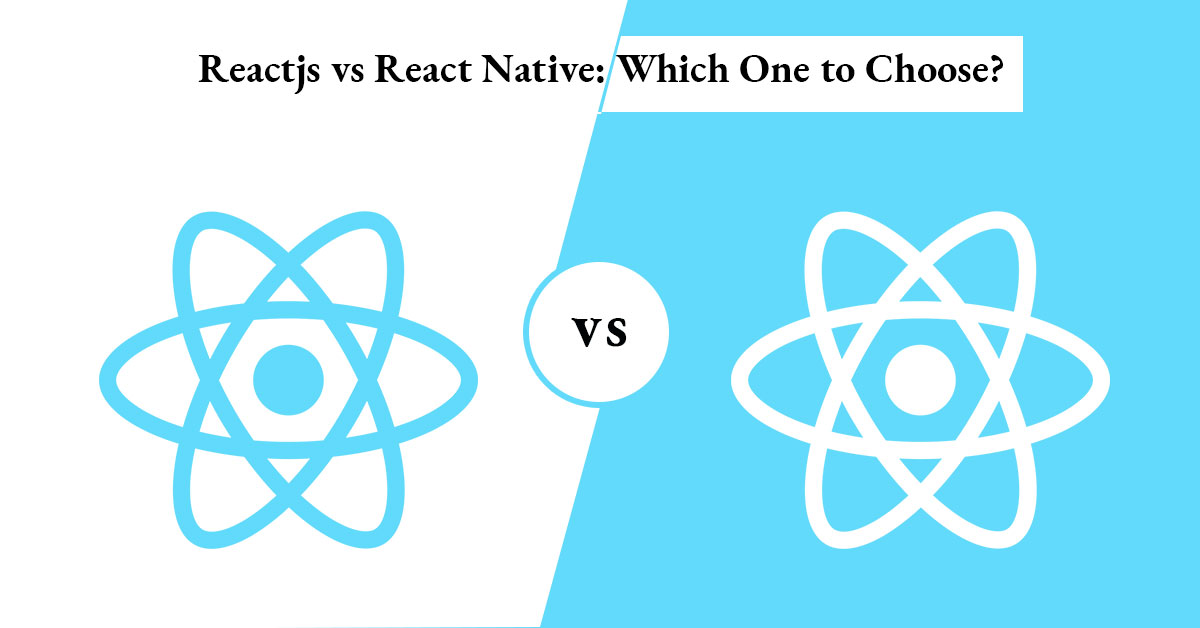Reactjs vs React Native: Which One to Choose?

4 min read | By Admin | 29 November 2021 |
Presently, the development platform languages have proliferated and raised up exponentially also converting the way businesses operate around the globe.
There are more than 600 languages in programming, each with its pros and cons, also it can change and evolve simultaneously.
Of these various programming languages, React JS and React Native is the most prominent frameworks in the field of mobile and web app development.
Significantly, React JS is one of the most popular libraries for creating web apps, and React Native is a framework based on React JS, designed for direct use to build mobile apps with all the advantages of the latter.
Reactjs and React Native is developed by Facebook and these are JavaScript libraries for building user interfaces. Both of these have merits and demerits when it comes to developing mobile or web apps and websites.
You may know about both of these but have no idea which of these is the best? Don’t get confused! This article will finely help you to find the eminent one. So, let’s start the discussion of Reactjs vs React Native.
The History of Reactjs and React Native

Reactjs
⦿The Initiation – 2010
Facebook introduced xhp in its PHP stack and made it open source. Xhp allowed creating composite components. They later introduced this syntax into React.
⬇⦿An early prototype of React – 2011
Jordan Walke created FaxJS, the initial prototype of React – a search element sent to Facebook.
⬇⦿New things started at Facebook – 2012
In 2012, Facebook acquired Instagram. Consequently, ReactJS became the innovation that Instagram needed.
⬇⦿The Big Launch – 2013
Facebook publicly open-sourced ReactJS in May 2013. Initially, people were skeptical about the library. However, over time ReactJS has become one of the preferred application development technology stacks for developers.
⬇⦿The Expansion – 2014
Gradually, Reactjs gained stability and recognition among large communities. Large companies began to notice the language. The reactjs world tour conference started as well.
⬇⦿React was Stable – 2015
In 2015, Jordan Walke introduced a powerful React Native framework in public, and the first stable version of the new React Developer Tools was launched.
⬇⦿Gained more recognition – 2016
React gained more recognition with new conferences and new libraries such as MobX and BlueprintJS were released which were highly appreciated by the developing communities.
⬇⦿Further improvements – 2017
The new releases of the open-source library React Sketch.app and improved Support for Fragments. React Fiber gets open-sourced at F8 2017.
⬇⦿Updated and improved – 2018
The React tools were updated and improved and worldwide conferences were held.
⬇⦿New React DevTools – 2019
The launch of the novel React DevTools.
⬇⦿Zero-Bundle-Size react server components – 2020
Introduced zero-bundle-size React server components for initial feedback from the React development community.
⬇⦿The Plan for React 18 – 2021
React 18 is now in beta. More information about the status of the release is available in the React 18 Working Group post.
React Native
⦿Facebook released React Native – 2015
Facebook released React Native in 2015 and has been maintaining it ever since. React Native was open-sourced and made available on GitHub, also React Native for android was also made available.
⬇⦿Facebook developers announcement – 2016
In 2016 React Native framework’s Facebook developers announced that the React Native framework could support Windows and Tizen platforms as well.
⬇⦿Introducing create React Native app – 2017
A new tool that makes it significantly easier to get started with a React Native project. With Create React Native App, there’s no need to use Xcode or Android Studio, and you can develop for your iOS device using Linux or Windows.
⬇⦿Releasing 0.56 – 2018
In 2018, the long-awaited 0.56 version of React Native is now available. Implementation of Twitter’s app loading animation in React Native.
⬇⦿New version 0.61 – 2019
The new version of 0.61 is released with a fast refresh feature.
⬇⦿Another version – 2020
The version of 0.63 was released that ships with LogBox turned on by default. Also, the React Native version 0.62 includes support for Flipper by default.
⬇⦿Announcing React Native 0.65 – 2021
React Native version 0.65 with a new version of Hermes, improvements to accessibility, package upgrades, and more.
What is Reactjs?
A JavaScript library for building user interfaces. React makes it painless to create interactive UIs. Builds encapsulated components that manage their own state, then compose them to make complex UIs.
React JS was originally created by Jordan Walke. Today, React has over a thousand open source contributors. React allows you to interface with other libraries and frameworks.
React can also render on the server using Node and power mobile apps using React Native. Since component logic is written in JavaScript instead of templates, you can easily pass rich data through your app and keep the state out of the DOM.
Pros of ReactJS

➊ 𝐏𝐞𝐫𝐟𝐨𝐫𝐦𝐚𝐧𝐜𝐞 𝐄𝐧𝐡𝐚𝐧𝐜𝐞𝐦𝐞𝐧𝐭: ReactJS improves performance due to virtual DOM. The React Virtual DOM exists entirely in memory and is a representation of the web browser’s DOM.
➋ 𝐄𝐚𝐬𝐲 𝐭𝐨 𝐋𝐞𝐚𝐫𝐧 𝐚𝐧𝐝 𝐔𝐬𝐞: ReactJS is much easier to learn and use. Any developer who comes from a JavaScript background can easily understand and start creating web apps using React.
➌ 𝐑𝐞𝐮𝐬𝐚𝐛𝐥𝐞 𝐂𝐨𝐦𝐩𝐨𝐧𝐞𝐧𝐭𝐬: A ReactJS web application is made up of multiple components, and each component has its logic and controls. These components can be reused wherever you need them. The reusable code helps to make your apps easier to develop and maintain.
➍ 𝐒𝐮𝐩𝐩𝐨𝐫𝐭 𝐨𝐟 𝐇𝐚𝐧𝐝𝐲 𝐓𝐨𝐨𝐥𝐬: ReactJS supports a handy set of tools that make the task of the developers understandable and easier. It also allows you to select particular components and examine and edit their current Props and State.
➎ 𝐃𝐲𝐧𝐚𝐦𝐢𝐜 𝐖𝐞𝐛 𝐀𝐩𝐩𝐬 𝐁𝐞𝐜𝐨𝐦𝐞𝐬 𝐄𝐚𝐬𝐢𝐞𝐫: To create a dynamic web application specifically with HTML was tricky, which requires complex coding, but React JS solved that issue and makes it easier. It provides less coding and gives more functionality.
Cons of ReactJS
➊ 𝐇𝐢𝐠𝐡 𝐏𝐚𝐜𝐞 𝐨𝐟 𝐃𝐞𝐯𝐞𝐥𝐨𝐩𝐦𝐞𝐧𝐭: As we know, the frameworks continually change so fast. The developers are not feeling comfortable to re-learn the new ways of doing things regularly.
➋ 𝐏𝐨𝐨𝐫 𝐃𝐨𝐜𝐮𝐦𝐞𝐧𝐭𝐚𝐭𝐢𝐨𝐧: React technologies updating and accelerating so fast that there is no time to make proper documentation. To overcome this, developers write instructions on their own with the evolving of new releases and tools in their current projects.
➌ 𝐕𝐢𝐞𝐰 𝐏𝐚𝐫𝐭: ReactJS covers only the UI Layers of the app and nothing else. So you still need to choose some other technologies to get a complete tooling set for development in the project.
➍ 𝐊𝐧𝐨𝐰𝐧 𝐭𝐨 𝐛𝐞 𝐒𝐄𝐎 𝐅𝐫𝐢𝐞𝐧𝐝𝐥𝐲: Traditional JavaScript frameworks have an issue in dealing with SEO. ReactJS overcomes this problem, which helps developers to be easily navigated on various search engines.
➎ 𝐁𝐞𝐧𝐞𝐟𝐢𝐭 𝐨𝐟 𝐇𝐚𝐯𝐢𝐧𝐠 𝐚 𝐉𝐚𝐯𝐚𝐒𝐜𝐫𝐢𝐩𝐭 𝐋𝐢𝐛𝐫𝐚𝐫𝐲: Today, ReactJS is gaining popularity among web developers. It is offering a very rich JavaScript library that provides more flexibility to the web developers to choose the way they want.
What is React Native?

React Native is a JavaScript framework for writing real, natively rendering mobile applications for iOS and Android. React Native combines the best parts of native development with React, a best-in-class JavaScript library for building user interfaces.
Specific versions of components so a single codebase can share code across platforms. With React Native, one team can maintain two platforms and share a common technology.
React Native lets you create truly native apps and doesn’t compromise your users’ experiences. It provides a core set of platform-agnostic native components like View, Text, and Image that map directly to the platform’s native UI building blocks.
With the power of JavaScript, React Native lets you iterate at lightning speed. No more waiting for native builds to finish. Save, see, repeat.
Pros of React Native
➊ 𝐉𝐚𝐯𝐚𝐒𝐜𝐫𝐢𝐩𝐭: JavaScript knowledge is used to build native mobile apps.
➋ 𝐂𝐨𝐦𝐦𝐮𝐧𝐢𝐭𝐲: The large community of ReactJS and React Native helps us to find any answer we require.
➌ 𝐇𝐨𝐭 𝐑𝐞𝐥𝐨𝐚𝐝𝐢𝐧𝐠: Making a few changes in the code of your app will be immediately visible during development. If the business logic is changed, its reflection is live reloaded on-screen.
➍ 𝐂𝐫𝐨𝐬𝐬-𝐏𝐥𝐚𝐭𝐟𝐨𝐫𝐦 𝐔𝐬𝐚𝐠𝐞: It provides the facility of “Learn once write everywhere.” It works for both platform Android as well as iOS devices.
➎ 𝐂𝐥𝐚𝐬𝐬 𝐏𝐞𝐫𝐟𝐨𝐫𝐦𝐚𝐧𝐜𝐞: The code written in React Native is compiled into native code, which enables it for both operating systems as well as it functions in the same way on both platforms.
Cons of React Native
➊ 𝐓𝐚𝐤𝐞𝐬 𝐌𝐨𝐫𝐞 𝐓𝐢𝐦𝐞 𝐭𝐨 𝐈𝐧𝐢𝐭𝐢𝐚𝐥𝐢𝐳𝐞: React Native takes a lot of time for initializing the runtime even for the hi-tech gadgets and devices.
➋ 𝐒𝐭𝐢𝐥𝐥 𝐍𝐞𝐰 𝐚𝐧𝐝 𝐈𝐦𝐦𝐚𝐭𝐮𝐫𝐞: React Native is a newbie in Android and iOS programming languages and is still in its improvement stage, which can have a negative impact on the apps.
➌ 𝐋𝐞𝐚𝐫𝐧𝐢𝐧𝐠 𝐢𝐬 𝐓𝐨𝐮𝐠𝐡: React Native is not easy to learn, especially for a fresher in the app development field.
➍ 𝐋𝐚𝐜𝐤𝐬 𝐭𝐡𝐞 𝐒𝐞𝐜𝐮𝐫𝐢𝐭𝐲 𝐑𝐨𝐛𝐮𝐬𝐭𝐧𝐞𝐬𝐬: React Native is a JavaScript library and open-source framework, which creates a gap in the security robustness.
Difference Between Reactjs and React Native
ReactJS
⒈ The ReactJS initial release was in 2013.
⒉ It is used for developing web applications.
⒊ It uses a JavaScript library and CSS for animations.
⒋ It uses React-router for navigating web pages.
⒌ It can be executed on all platforms.
⒍ In this, the Virtual DOM renders the browser code.
⒎ It can use code components, which saves a lot of valuable time.
⒏ It uses HTML tags.
React Native
⒈ The React Native initial release was in 2015.
⒉ It is not platform independent. It takes more effort to be executed on all platforms.
⒊ It comes with built-in animation libraries.
⒋ It is used for developing mobile apps.
⒌ It does not use HTML tags.
⒍ It has a built-in Navigator library for navigating mobile applications.
⒎ It can reuse React Native UI components & modules which allow hybrid apps to render natively.
⒏ It provides low security in comparison to ReactJS.
Reactjs vs React Native Which is Better?
Reactjs and React Native are both key pillars of apps and web development, and they are gaining momentum day by day due to their flexible functionality and the ecosystem of emerging libraries.
Although Reactjs is basically a JavaScript library and React Native is the whole structure, the former is the heart of the latter and appreciates each other.
If Reactjs is optimized to build applications with high functionality and complex computations, React Native is best for giving your mobile apps a native feel.
There are limits to every technology or framework in the developer universe, including Reactjs and React Native. That is why we made the pros and cons of reactjs vs react native.
Hence consider the two technologies and then make a wise decision based on precedence and desirable results.
The latest from our editors
Join over 150,000+ subscribers who get our best digital insights, strategies and tips delivered straight to their inbox.


